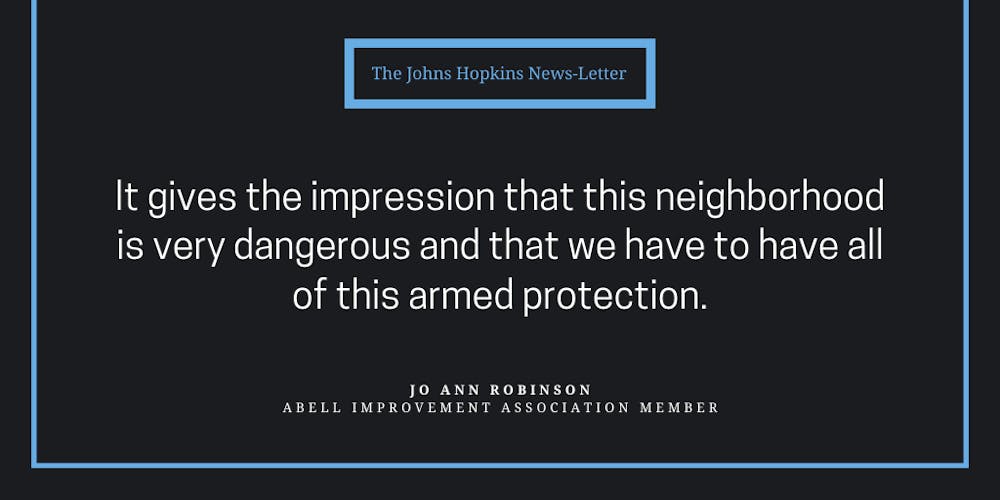In light of recent developments with the Johns Hopkins Police Department (JHPD), the Abell Improvement Association (AIA), the neighborhood improvement association for the Abell community in Charles Village, reflected on the effect of the JHPD on neighboring communities.
The AIA voted in opposition to the JHPD in April 2019. Maureen Daly, the former president of AIA, discussed the organization’s decision making processes in an interview with The News-Letter.
“There was a great deal of discussion at that meeting, and many different positions were presented,” she said. “When the University proposed [the plan for an armed police force], they expressed a perception that Baltimore is dangerous and that an armed police force would address that problem, but there was a strong feeling in the community that an armed private police force would not address community problems but might lead to greater violence and bigger problems.”
Daly further emphasized that many surrounding neighborhood associations have also stated their opposition to the implementation of the JHPD, including Old Goucher Community Association, Waverly Improvement Association, Greater Remington Improvement Association (GRIA) and Harwood Community Association (HCA).
In an interview with The News-Letter, Emil Volcheck, member of the AIA Committee to Oppose JHPD, stated that the AIA has yet to find an association to express their support, though many neighborhood associations have formally expressed their opposition to the implementation of the JHPD.
“There are neighborhoods around Hopkins that oppose the police department, and no neighborhood association is in support of JHPD,” he said. “We haven't been able to find a single one. Better Waverly, Charles Village Civic Association and Oakenshawe have officially no position.”
Jo Ann Robinson, former AIA president and a current member of the AIA Committee to Oppose JHPD, shared her concerns of implementing an armed police force in an interview with The News-Letter.
“It gives the impression that this neighborhood is very dangerous and that we have to have all of this armed protection,” she said. “Who wants to move into a neighborhood that is dangerous, who wants to send their kid to a university that is dangerous?”
Robinson emphasized that the University has the ability to implement creative efforts to maintain public safety and the quality of life in cooperation with the surrounding neighborhoods and residents of Baltimore.
Similar to Robinson, Daly noted that the University can play a positive role in the community through active engagement.
“We have some community involvement from Hopkins, that's very helpful, and we look for more of that,” she said. “[The University] sits on the Charles Village Community Benefits District Steering Committee, they've assisted with events with our own neighborhood association, and also, with the Merchants Association, Waverly Main Street and more.”
According to Volcheck, the Charles Village Community Benefits District Management Authority recorded that Part 1 crimes have dropped nearly 38% between 2013 and 2020 in the Charles Village Community Benefits District, which encompasses neighborhoods around the Homewood Campus. Part 1 crimes are crimes involving murder, rape, aggravated assault, robbery, burglary, larceny, motor vehicle theft and more.
“I was at a Safety Advisory Council meeting where a Hopkins representative said that the data shows we need the police force, but this data here shows that you can have a significant drop in crime without a police force,” he said. “I'm not saying that the unarmed patrol officers caused that — correlation is not causation — but this does show that you can get a substantial decrease without private armed police.”
Three neighborhood associations, AIA, GRIA, and HCA, have voted to ask Baltimore Police Commissioner Michael Harrison not to sign the memorandum of understanding (MOU)with the University.
Daly spoke about Vice President for Public Safety Branville Bard’s history of working in urban university neighborhoods, explaining that he should apply his knowledge in the community without implementing the armed private police force.
“Any MOU would have to have community support, so we would strongly object to our police department signing an MOU with the university because we don't want an armed police force in our neighborhood,” she said.
Robinson expressed her desire to have community members and residents be more involved with the University’s student body.
“I hear a little bit of the narrative that's being given: you've got to watch your back and don't go to this place, and while some of that is necessary, some of it’s just common sense,” she said. “I would love to tell [students] about the wonderful open space we have, where all kinds of things happen throughout the year, aspects of our community that are really very positive.”
She believes that if community members showed the Hopkins community what the surrounding neighborhood is truly like, the need for the armed police force would disappear.
Similar to Robinson, Daly commented on the narrative surrounding Baltimore and how that may be perpetuated by racism.
“We are a majority Black city, and I wonder about the prejudice. For many, I think that a Black community equals a dangerous community, and that is very regrettable and untrue,” she said. “I would love to give students an opportunity to communicate with different people in the community and find out about the really creative, inventive things that are happening here on all kinds of levels, many of which Hopkins is involved in.”





